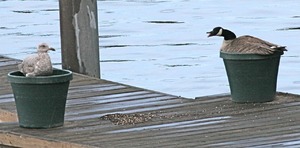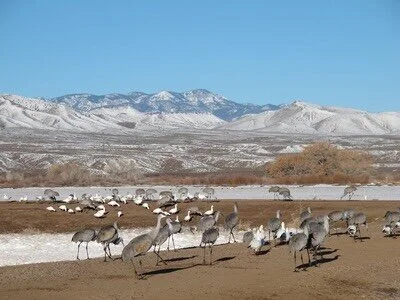words + photos by Alan Fritzberg
OMG. There’s a goose sitting in a flowerpot on the neighbor’s dock! There began a month plus of watching a goose nesting in what would seem like an odd, very visible and seemingly vulnerable location for the process on the shore of Lake Whatcom in Bellingham, Washington.
My 1950s boyhood memories of Canada geese are of my father dreaming of seeing one close enough to have a shot at. Near our house between Bellingham and the Canadian border they were usually seen only high overhead.
Nowadays, as we all know, geese are seemingly everywhere there is water and, especially, freshly cut grass.
The geese we see in our area are nonmigratory residents, thanks to the U. S. Department of Fish and Wildlife. In response to declining goose populations in the first half of the 20th century, eggs were incubated separately from parents so the goslings could be raised without being taught to migrate. Success in this recovery endeavor was defined as improved hunting opportunities.
Being in the habit of shooing geese off the property, how should I react to a goose that has decided to nest in a large flowerpot on a neighbor’s dock? My first inclination was to move the goose along to the next grassy yard.
Our neighbor who put the flowerpot on the dock was excited to see a goose sitting in it. I realized it was not my role to call a halt or try to figure out how to oil the eggs or whatever one does to un-fertilize them in order to make a small impact in retarding the population growth of our western resident Branta Canadensis moffitti.
Questions Arose
Was the goose a young first timer and didn’t know any better? Could it actually nest in a 15-inch diameter flowerpot and incubate eggs to hatching status? Was it vulnerable in so conspicuous a spot?
The goose appeared in the flowerpot on April 16. There were two pots, one on each side of the dock. The goose began by sitting in the pot, then hopping out and flipping soil out of the other pot onto the dock. Next it selected larger clumps of soil and placed them in the other pot. After working on this for a few hours, it hopped into the flowerpot and began the first of many hours of many days sitting in it.
Over the next several days mother-to-be goose spent most of the time just sitting in the flowerpot with the occasional break for a bit of nearby lawn grazing. During one of the times that she was away on April 28, closer viewing of the flowerpot nest suggested something different inside. No eggs were immediately visible, but the nest was covered in feathers. It turns out that nesting geese actually pull out breast feathers to line the nest.
On the 16th of May, a month after the beginning of the sitting on the nest, the goose left again and I went out on the dock to have a look in the flowerpot. As the time was getting to a point where they should be hatching, were there really eggs in the nest?
I expected the geese to come back and chase me away, but the pair just continued eating the neighbor’s grass about 50 yards away and seemed unconcerned about my being close to the nest. At that time there appeared to be at least three and maybe four large eggs in the nest.
Thirty-Three Days of Nesting
Finally on May 19, 33 days after the initial observation of flowerpot nesting, two goslings were more or less walking on wobbly legs on the dock. Another gosling was in the water bouncing around in windy conditions. Being likely less than an hour old, it seemed that the swimming gosling might be in danger, but it was obviously quite capable of swimming between dock sections and managing the windy conditions.
The mother goose continued to stay on the nest and the father goose stood on the dock while the two goslings were taking a few steps and clumsily falling back on their rear ends.
Within 30 minutes all three goslings were in the water. The father goose finally deemed it appropriate to join them and he and the three little ones paddled about 30 yards to the shore. A short time later the mother left the nest and joined the mate and little ones.
Shortly afterwards, two more heads appeared above the flowerpot edge. As the parents were both on shore, I went out on the dock to have a close look and found out that there were three more goslings in the nest making a total of six.
 In a matter of 20 minutes or so, two goslings made it over the side of the flowerpot and down to the dock with the parents and the first three goslings watching from the shore. One at a time the two newest goslings hopped into the lake and paddled across to join the family.
In a matter of 20 minutes or so, two goslings made it over the side of the flowerpot and down to the dock with the parents and the first three goslings watching from the shore. One at a time the two newest goslings hopped into the lake and paddled across to join the family.
One gosling remained in the nest while the parents and other five watched. It was weaker and at times made cheeping noises while raising its head above the flowerpot rim. However, it apparently was too weak to make it over the edge and down to the dock. Neither of the parents made an effort to come back and provide aid to the last gosling.
As the last gosling became weaker the clouds thickened darkening the afternoon sky. Large raindrops splashed into the lake. A crow flew out to the flowerpot and looked in. Within a few minutes the crow had killed the last gosling and begun to eat, nature’s reality played out.
The family disappeared for several days and afterwards reappeared regularly showing their usual ownership of the neighbors’ grassy areas. The first time they were seen on May 28, nine days after hatching, the five goslings had grown substantially. On the June 1 “visit” there were only four goslings, as on later visits. A little more than two weeks after hatching, the goslings were the size of adult chickens, an amazing growth considering their nutrition being extracted from their grassy diet.
The experience of observing the process from nesting to egg hatching of the geese, albeit with the underlying concern of still more geese sharing the lake shore, stimulated me to learn more.
Canada Geese Lay an Egg a Day
Typically Canada geese lay an egg a day to an average of five eggs known as a clutch and then sit on the nest for 28 to 30 days. In this case it appeared to take 33 days, but I didn’t have any knowledge of the time period the egg laying process occurred.
“Father” goose was clearly around, but most of his time was spent grazing on lawns some distance down the shore. The male fulfilled the role of generally being far enough away to not give away the location of the nest. What we primarily observed was a major dedicated investment of time by the mother goose on the nest, which is much more than can be said for the father-to-be.
Once the goslings arrived, both parents appeared to be equally involved in escorting the little ones, often keeping the goslings close between them. They don’t do much more obvious parenting than that as the goslings started pulling on grass and eating as soon as they were on shore, hours after hatching.
On the 16th of May, 30 days after she began sitting on the nest, two proud families came by showing off their gosling yield. At that time we saw the most dramatic territorial actions of the dock nesting pair with much neck extension and bobbing, hissing and chasing away of the other geese.
 There were other dock visitors as well including ducks and a gull. The nesting female did not respond to the ducks as they napped near her flowerpot, but did have a wary eye on the gull as it slowly sidled in for a closer check on things. At one point the gull hopped up on the adjacent flowerpot, perhaps dreaming about a goose egg meal.
There were other dock visitors as well including ducks and a gull. The nesting female did not respond to the ducks as they napped near her flowerpot, but did have a wary eye on the gull as it slowly sidled in for a closer check on things. At one point the gull hopped up on the adjacent flowerpot, perhaps dreaming about a goose egg meal.
Female geese start laying eggs at age three. They are philopatric meaning that if the flowerpot is on the dock next spring, mother goose will probably be back to nest in it. The family is sometimes away for a several days, but regularly returns to graze the neighbors’ lawns.
Geese have a life expectancy of up to 20 years. This immediately suggests that with four goslings making it to adulthood, a lot more geese will be sharing our lawn space as the years add up.
This brings one to the question of numbers of Canada geese. Estimates for 2008 are 3.6 million resident geese in North America. Most of these millions are in the Atlantic, Mississippi and Central Flyways with only about 100,000 in the Western Flyway. The Western Flyway geese are comprised of the western Canada geese subspecies or race while the other flyways contain more subspecies.
Geese numbers have grown from near extermination over much of their range (due to unregulated hunting, habitat destruction and egg collecting in the early 20th century) to a recovery success story beyond anything the U. S. Fish and Wildlife biologists thought possible.
While my tendency around Canada geese is to act like a border collie, this opportunity for close observation of the nesting through hatching process has turned into an interesting experience and has provided a greater appreciation for these common but impressive waterfowl that we share space with.
Alan Fritzberg lives in Bellingham, WA with his wife Lisbeth and is currently retired from pharmaceutical development.

